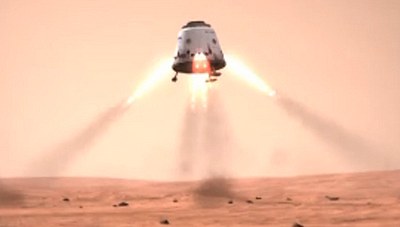Exploration initiatives from the private sectorby Lou Friedman
|
| New exploration proposals offer the hope that long-term vision need not conflict with short-term profits. |
The space station was built, but the visionary long-range programs have all faltered. They failed to create any political resonance. The situation is now worse than ever with no one on a national stage advocating human space exploration goals. The Administration seems to have given up, and Congress is focused only on special interests.
But there have been two recent infusions of fresh air into the human space exploration vacuum. They are competing initiatives, but they both are interesting and worth pursuing. They also both offer the hope that long-term vision need not conflict with short-term profits.
Elon Musk, who entered the space business driven by a personal goal of sending humans to Mars, has made the bold suggestion that his Dragon capsule can be a Mars lander for both humans and their robotic precursors. It’s bold: NASA has never recognized that human and robotic space exploration are a pair of eyes providing the same space vision. It’s bold also because it proposes that a design optimized for Earth entry can also work at Mars. Usually trying to meet two sets of diverse mission requirements with one system doesn’t work out. But the suggestion here is that the Mars lander will not be driven by such requirements but by whatever capabilities it may offer for the robotic precursor. The precursor will be an explicit pathfinder for humans.
Elon’s suggestion comes at a good time—so good that we will have to be careful to not let wish replace thought. The human exploration program is rudderless, and the robotic exploration program is foundering due to over-budgeted, unaffordable mission plans. The plans for the next set of Mars missions after MSL keeps getting whittled down by budget cutters and we are not at all sure of what missions may fly, if any, in the second half of the current decade. The proposal for a Red Dragon (the SpaceX capsule to Mars) is a shot in the arm and ought to stimulate some new thinking for the future of Mars exploration. Maybe it can be a private-public partnership like those being planned for post-shuttle US Earth orbit transportation, and maybe the robots really can pave the road for humans.
| Not only do these ideas need study and encouragement (and seed funding), but their context as private company contributions to a national vision needs to be harnessed and used. |
Equally bold is the proposal by Lockheed Martin engineers for a mission they call “Plymouth Rock”: sending humans to a near Earth asteroid (NEA) (see “Charting a Flexible Path”, The Space Review, September 27, 2010). I like the name a lot: it deals with the put-down that some feel about sending humans to a NEA, namely, that there is no there, there. Plymouth Rock is not the ultimate human destination, no more that the original Plymouth Rock was for the Pilgrims. But it is a perfect stepping-stone as are other NEAs as we move outward into the solar system. The value of such a mission got a boost in a recent Open Global Community NEO (near-Earth object) Workshop, called “Target NEO.” Their conclusion coincided with the conclusion that scientists and planetary defense people have reached: we need a space-based survey to find the many undiscovered NEOs.
The Lockheed proposal, like that of SpaceX, is driven by their interest in marketing their new human space transportation vehicle. For Lockheed, the vehicle is Orion, and for SpaceX, it is Dragon. They both have a long way to go from cargo resupply vehicle to human transportation vehicle, and even longer to meeting planetary mission requirements, but, they seem to know where they are going—much more so than does the government. That probably comes from having a Board of Directors with fewer than 535 people, each protecting their fiefs.
Not only do these ideas need study and encouragement (and seed funding), but their context as private company contributions to a national vision needs to be harnessed and used. That is happening in Earth orbit in communications, navigation, remote sensing, and, now, in transportation. We can do that beyond Earth orbit, too—it just requires government investment to be refocused from the rocket to nowhere to missions to somewhere.
